Original title: DeFi's next milestone: What it'll take for agentic finance to work
Original author: @Lemniscap
Original translation: Ismay, BlockBeats
Editor's Note: When the world of DeFi becomes so complex that even professional users find it difficult to control, how can we return the initiative to ordinary people?
This research article from Lemniscap systematically examines the rise and current challenges of "intelligent agent finance." From &milo and Meridian to SendAI and The Hive, these early products demonstrate how AI can become a new interface for on-chain interactions, but they also expose significant gaps in execution reliability, permission security, and verification mechanisms. The author argues that the key to DeFi's next phase lies not in smarter models but in a more trustworthy underlying structure—one that ensures that every action taken by agents is verifiable, traceable, and trustworthy.
This is not only a turning point in technological evolution, but also an experiment in the reconstruction of trust. As the article states: The next milestone for DeFi is not greater scale, but trust in automation.
By 2025, DeFi will look nothing like its early days.
The data speaks for itself: Institutional funds inflows exceeded $10 billion in a single quarter, and the number of active protocols across dozens of chains exceeded 3,000. The total locked-in value of DeFi protocols across the entire network reached $160 billion in 2025, a year-on-year increase of 41%. The cumulative trading volume of DEXs and Perps is measured in trillions.
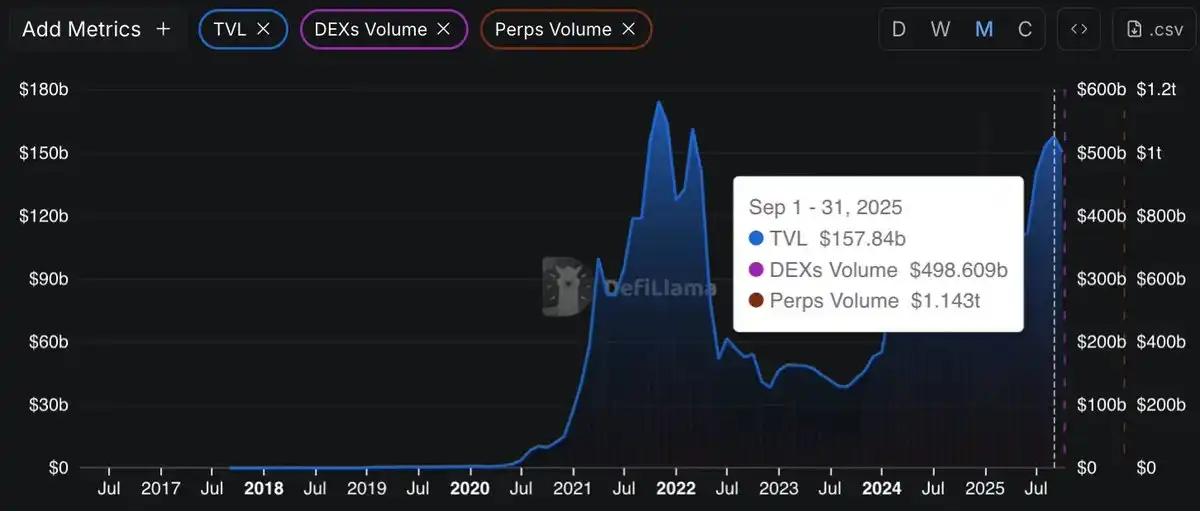
As DeFi grows in scale, the possibilities for doing more and more are expanding, but the complexity is also skyrocketing. Most people simply can't keep up with everything happening on-chain. If we want more people to seize these new opportunities, we must build tools that make it easier for users to make the right decisions—and that's where the future is headed.
At the same time, AI has become increasingly integrated into daily life, and people are starting to develop new habits around automation. This trend has given rise to "agentic finance," where intelligent agents handle the navigation and execution of financial operations.
Even simple browser-based proxies like Comet demonstrate the rapid evolution of these tools. When you perform a DeFi operation through a browser proxy (as in the example shared by SendAI founder Yash), you can see the potential of intelligent agent finance.
The vision is straightforward: instead of searching through dashboards or long posts on X, you can simply tell the AI what you want to achieve, and it will automatically help you complete the next steps.
Two categories of intelligent agents are emerging:
One type is Copilots, which guide users to make decisions in the entire DeFi world; the other type is Quant Agents, which are more inclined to professional automated strategy execution, equivalent to "Autopilots".
Both are still in their early stages and have flaws, but together they point in a new direction—a radically different, AI-driven way of interacting with DeFi.
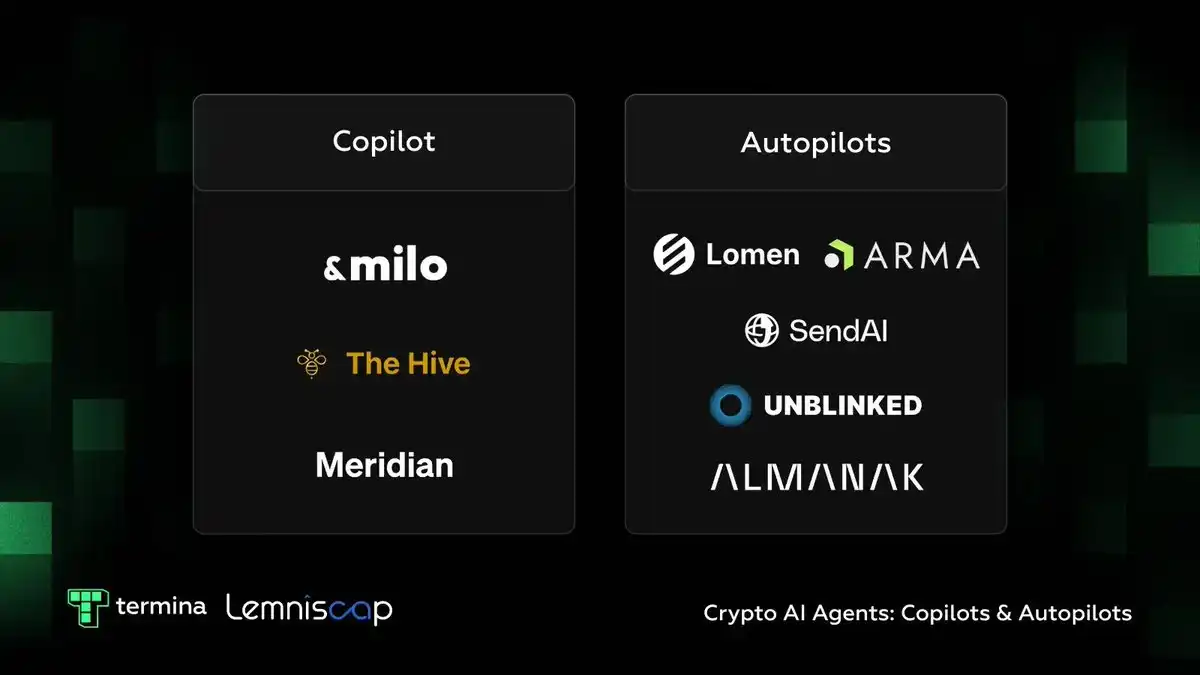
Intelligent Agent as Co-Pilot
Think of these intelligent agents as your personal assistant. No longer needing to scroll through charts or jump between protocols, you can simply ask natural language questions like, "What are the hottest tokens right now?" or "Where can I find the best returns?" and the agent will answer directly and recommend next steps—like a knowledgeable friend always on hand.
Take &milo as an example. Its co-pilot mode can assist you in making investment decisions, rebalancing assets, and gaining portfolio insights - allowing you to stay in control while eliminating tedious operations.
Using natural language interpretation and intelligent prompts, &milo helps users understand their positions and compare profit opportunities without having to search for data in various dashboards. It demonstrates the evolution of co-pilot agents from simple chat assistants to full-fledged DeFi guides.

To see how these agents perform in practice, we tried out several recently released products to see firsthand how well they handle real-world DeFi tasks.
The results showed that these agents still have limitations. For example, they successfully identified popular tokens but were unable to execute buy operations. Two transactions also failed with the system indicating "insufficient balance" even though there was actually enough SOL in the account to cover the transaction fee.
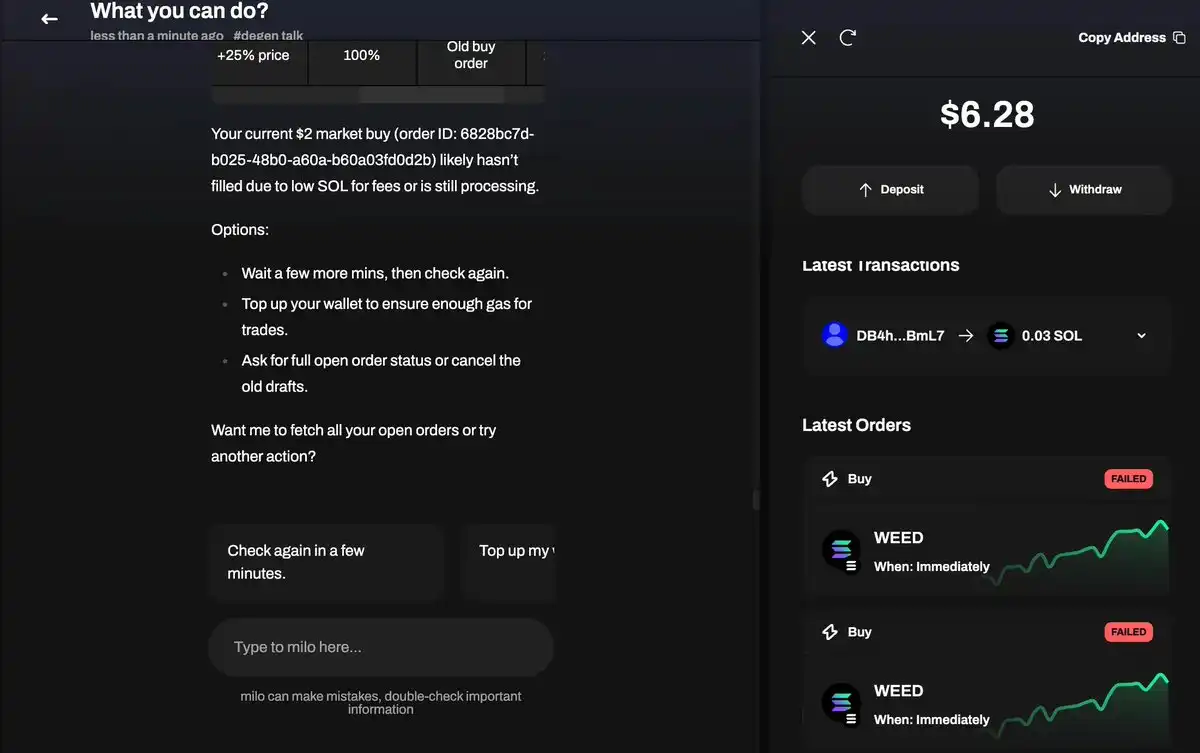
A similar platform, The Hive, takes a different approach. It organizes multiple DeFi agents into a "swarm," capable of collaboratively completing complex tasks such as cross-chain transactions, yield strategies, and liquidation defenses, all coordinated through a simple chat interface. This network of specialized agents can complete multi-step on-chain operations using natural language commands.
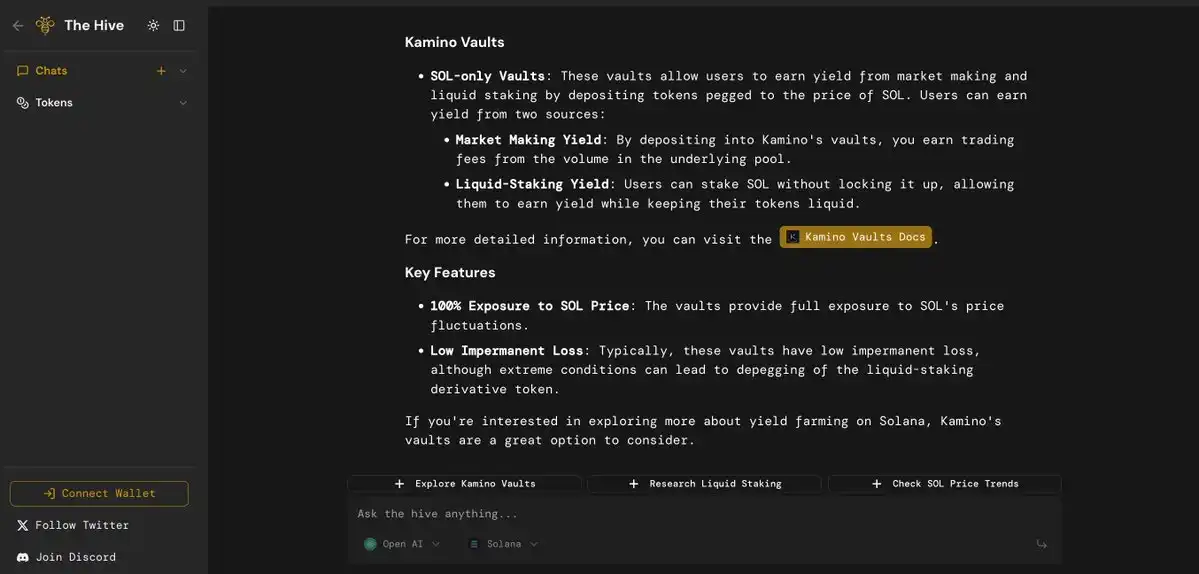
We tested the same buy command using The Hive. The system did recognize the popular token WEED, but returned the wrong contract address when executing the purchase.
Overall, Milo demonstrates how portfolio management tools can be integrated into a seamless process, while The Hive explores how to enable multiple specialized agents to work together. As the capabilities of intelligent agents increase, they will begin to develop a clearer division of labor.
For example, Meridian focuses on the other end of the user spectrum—helping beginners take their first steps into DeFi. Its mobile-first design, coupled with clear prompts, makes basic operations like swapping tokens, staking, or checking returns easier to use.
Meridian performs smoothly and quickly on these core tasks, and more importantly, it is very clear about its own boundaries. When users ask it to perform an operation beyond its scope, it will explain the reason instead of blindly trying. This honesty makes it a reliable starting point for novices to explore the world of on-chain.
Meridian founder Benedict explained:
Meridian allows users to securely research and operate using natural language. We have made the broker's research functionality available to the public for free at meridian.app. Users who register for the Meridian mobile app can use the broker's swap, multi-swap, and portfolio purchase features. Currently in closed beta, interested users can contact @bqbrady on Twitter to request a trial.
Through our testing, we found that most of the AI agents currently focused on DeFi navigation are still in the role of "teachers" or "assistants", mainly helping users complete the most basic operations (such as currency exchange).
Further improvements are still needed before they can reliably handle more complex processes such as providing liquidity and managing leveraged positions.
As Rishin Sharma, Head of AI at the Solana Foundation, noted:
"Large language models (LLMs) are prone to hallucinations when handling a wide range of tasks and struggle to execute deterministic operations. Function call mechanisms like MCP may be more suitable for translating 'action plans' into actual execution. While LLMs perform well at the conception and guidance levels, they still struggle with precise execution. To make intelligent agent finance truly reliable, we must go beyond LLMs and develop specific function call mechanisms, clear execution policies, verifiability, and a secure permission system. In other words, the execution layer of today's intelligent agents is still underdeveloped—the AI 'brain' is smart enough, but it lacks a 'body' that can act reliably."
As an intelligent agent for "autonomous driving"
If "co-pilot" agents are more like mentors, then "quantitative" agents are more like autopilot systems. They not only build strategies but also execute them—monitoring the market in real time, testing trades, and acting automatically at machine speed, putting complex DeFi strategies into "full autopilot" mode.
A prime example emerging is SendAI. It's not a quantitative agent per se, but rather a toolkit that enables others to create such agents. Its "Agent Kit," designed for Solana, supports over 60 autonomous operations, including token swaps, new asset issuance, and loan management, and can directly interact with mainstream protocols like Jupiter, Metaplex, and Raydium.
In other words, it provides developers with a "rail system" that allows them to connect decision models directly to the chain for execution.
SendAI founder Yash clearly outlined their vision:
“We believe that every AI agent will have its own wallet in the future. SendAI is building the tools and economic layer needed to enable these agents to perform any action on Solana. We are building a platform that makes these agents contextually aware and supports long-running, persistent, and asynchronous execution of complex tasks.”
Meanwhile, other teams are working to make this capability more accessible. Lomen curates strategies and enables users to deploy them with one click, lowering the barrier to entry for users to enjoy quantitative automation without writing code.
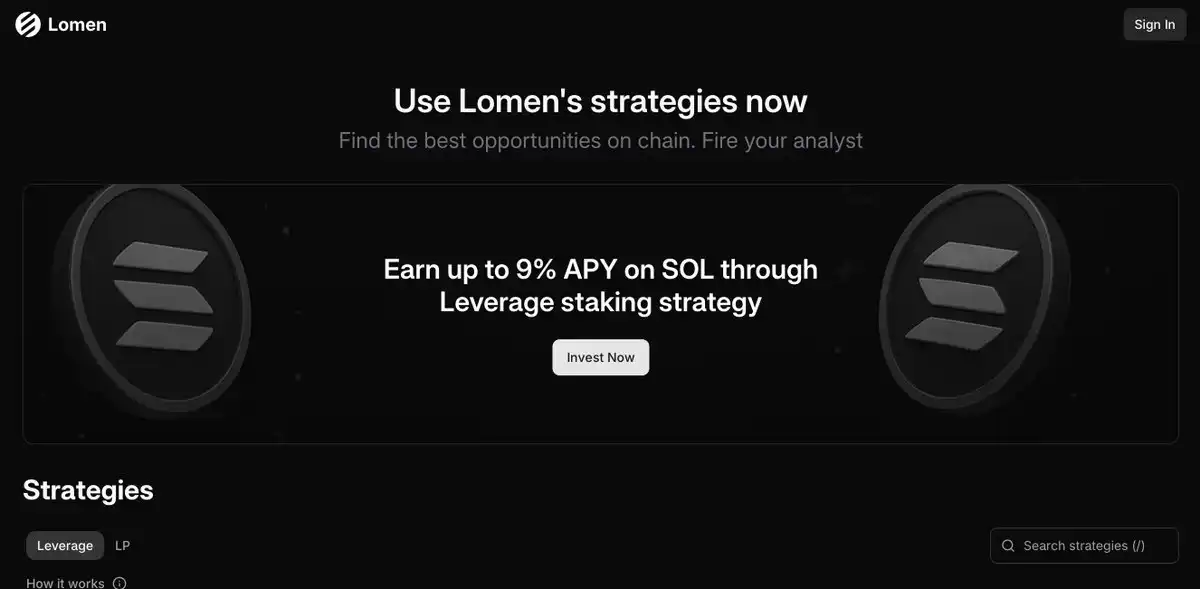
For advanced traders who prefer a more customized system, Unblinked offers an AI-powered strategy experimentation environment. It's like Cursor for trading: users can sketch out their strategy ideas, run and optimize them in a secure sandbox environment, and then decide whether to invest real money.
Some platforms choose to call multiple agents to collaborate to complete tasks at the same time.
For example, Almanak combines "programming agents" with "backtesting agents": users describe strategies in natural language, AI automatically generates production-level code, and backtests with more than 10,000 Monte Carlo simulations, ultimately generating a "ready-to-play" strategy.
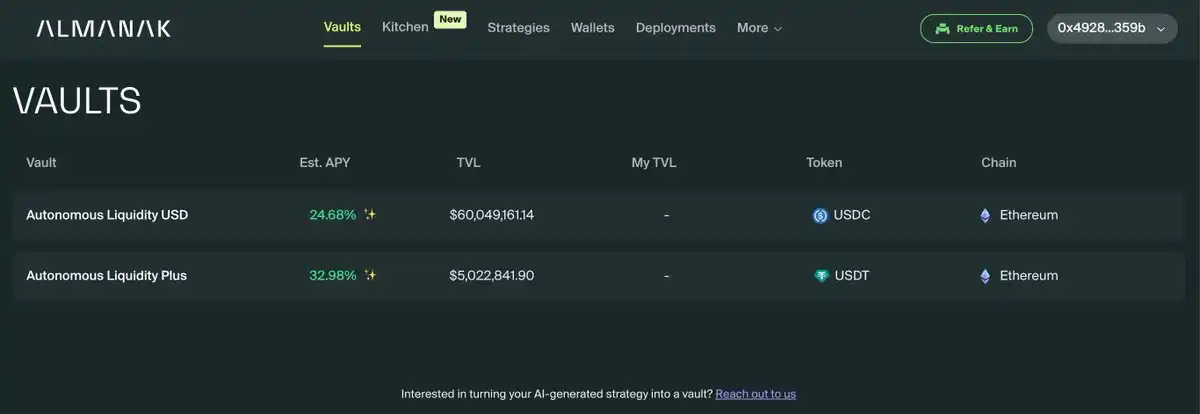
Finally, there are teams focused on real-time market advantage.
Giza's ARMA agents proactively allocate funds across lending protocols to maximize stablecoin returns. Rather than keeping funds stuck in a single pool, ARMA continuously monitors interest rates, liquidity, and gas costs, dynamically moving assets. Its flagship agent manages over $17 million and boasts a claimed yield 83% higher than static holdings.
Overall, these quantitative agents significantly reduce time costs and allow ordinary users to access complex strategies that were once the domain of professional quantitative teams. However, at the same time, they also reveal the fragility of automation: when data is delayed, protocols are suspended, or the market fluctuates violently, the agents may still "stumble."
In other words, they do make you faster, but they're far from invincible.
Their problem
Spend some time with current intelligent agents and you’ll notice some familiar issues: they sometimes suggest actions that no longer exist, like a long-closed liquidity pool; the data they rely on often lags behind the actual on-chain state; and if a multi-step plan goes awry, they don’t self-adjust, but instead try the same action over and over again.
Permission management is also clunky—users must either grant full access to their entire wallet or manually approve every minor action. Testing is similarly superficial, with simulations struggling to replicate the "real-world chaos" of sudden on-chain liquidity changes or governance parameter adjustments.
One of the most serious problems is that these proxies operate almost like black boxes.
Users have no way of knowing which inputs it read, how it weighed its options, whether it checked the real-time status, or why it chose to execute a particular transaction. Without a signature-verified operational record, it is impossible to verify the consistency between the "promised result" and the "actual execution."
Users can only use and "supervise" the automation process at the same time - which is not only inefficient but also makes performance difficult to evaluate.
Without a mechanism to validate decisions and prove that actions adhere to established strategies, users will never be able to distinguish between a reliable system and beautifully packaged marketing.
For larger-scale capital, DeFi platforms must shift from "trust us" to "please verify." This is also a critical turning point in building an "auditable, governable, and trustworthy" intelligent agent financial infrastructure.
Infrastructure gap
The core problem is that current systems lack the fundamental tools to ensure agents remain trustworthy, consistent, and secure at scale. To address this, we need infrastructure that can verify agent behavior, confirm execution results, and enforce consistent rules across all environments. Only then will people feel comfortable entrusting them with their money.
However, most users don’t really care about the agent’s “thought process”; they just want to confirm that the output is correct, verified, and within the security boundary. When it comes to building trust, “verifiable reliability” is more important than “visibility.”
This is where Verifiable Reliability comes in. Proxies don’t have to record every internal operation, but they should operate under clear policies and sanity checks: set spending limits, execution time windows, confirmation nodes before key operations, etc.
Under the hood, these rules can be enforced by a Trusted Execution Environment (TEE) or similar system—proving that the agent adheres to the boundaries without revealing all the details. The result: outputs that can be audited when needed, and operations that ordinary users can immediately trust.
This layer of verification doesn't have to be a one-size-fits-all approach. Everyday scenarios can employ lightweight security measures and standardized metrics, while high-risk or institutional scenarios may require stronger proofs and formal verification. The key is that each layer of infrastructure should provide measurable reliability commensurate with its risk level.
Make the protocol agent-ready
The next step to be filled is to make the protocol "agent-friendly".
Most current DeFi protocols are not designed for smart agents. They need to provide more stable and secure execution interfaces that allow for previewing operations, safe retries, and consistent execution based on consistent data structures. Permissions should also be limited rather than fully empowered, allowing agents to operate within clear boundaries rather than control the entire wallet.
Without these foundations, even the most intelligent agent framework will be tripped up by a fragile underlying infrastructure. Once these foundations are in place, users no longer need to manually monitor automation processes; development teams can reduce troubleshooting time and focus on innovation; and execution results from different service providers can be compared thanks to shared benchmarks—no longer just hype.
Parts that must be changed
The solution is actually quite simple: make the agent verifiable and the protocol agent-ready. Add a policy layer between the agent and the wallet, and require that all execution processes be traceable and verifiable, rather than operating in a black box.
For example, Termina's SVM engine is built on this principle—it provides a true Solana runtime environment for AI agents, enabling them to model, make decisions, and learn based on on-chain data. At the same time, the protocol should provide a "dry-run" interface with clear error codes, a safe retry mechanism, consistent core data structures (positions, fees, and health), and session-based permission control.
When these features are implemented, users will be freed from the burden of “minding” agents; teams will be able to reduce system failures; and institutional investors will finally have the safety rails and verifiable proofs they need.
Realistic timeline
Over the next six months, the fastest-growing improvements are expected to be in "co-pilot" agents, as improved data pipelines will increase their reliability in everyday use cases.
Within a year, as testing standards are strengthened, agents will be able to coordinate execution across protocols, with humans only needing to approve key steps. Longer term, as the infrastructure matures, smart agents may gradually blur into the default interaction layer of DeFi—no longer a separate “tool,” but the primary way people interact with the financial system on a daily basis.
Conclusion
Agentic Finance is lowering the barrier to entry, making automation no longer just a tool for experts. However, to truly operate at scale, it requires a better foundation: real-time data, more secure permission mechanisms, stronger testing systems, and more transparent execution results.
Smarter AI alone won’t solve these problems. Real progress will come from improving the underlying structures.
The next milestone for DeFi isn't just growth in scale, but trust in automation. This day will only come when AI agents stop being mere "conceptual demos" and become truly reliable executors.







